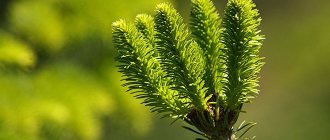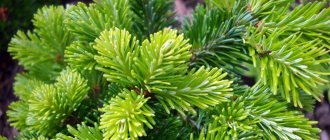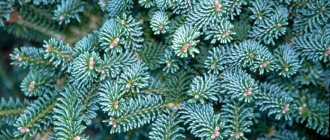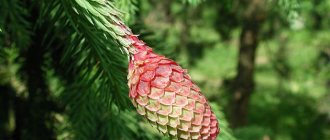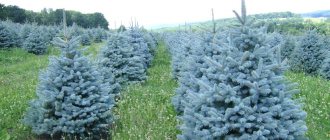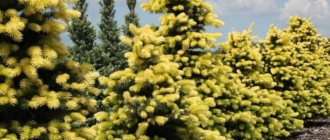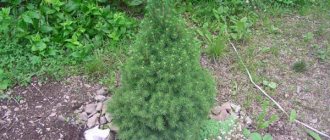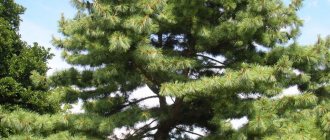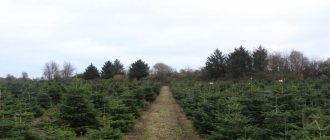| Siberian spruce | |
| Young Siberian spruces, Khanty-Mansiysk Autonomous Okrug (Russia) | |
| Save Status | |
| Least Concern (IUCN 3.1)[1] | |
| Scientific classification | |
| Kingdom: | Plantae |
| Clade : | Tracheophytes |
| Separation: | Pinophyta |
| Class: | Pinopsida |
| Order: | Pinales |
| Family: | Pinaceae |
| Genus: | Picea |
| Variety: | P. obovata |
| Binomial name | |
| Picea obovata Ledeb. | |
| Synonyms[2] | |
| |
Picea obovata
The
Siberian spruce
is a spruce native to Siberia, from the Ural Mountains east to the Magadan region, and from the Arctic tree line south of the Altai Mountains in northwestern Mongolia.
Botanical description of the species
Siberian spruce grows in the northern part of Europe and in the territories of Siberia. This tree is characterized by special endurance. It grows in low temperature conditions and is able to “survive” on permafrost lands. At a young age, it tolerates shading well, and in adulthood the plant prefers an abundance of light.
Did you know? The Khanty performed sacrifices for the spruce, as they considered the tree sacred and believed that the spirit of the forest lived in it.
The botanical description of the spruce species in question is as follows:
- size: large tree growing up to 30 m;
- crown shape: pyramidal;
- trunk diameter can reach 70 cm;
- dependence of growth rate on lighting;
- needles: short, prickly;
- cones: first erect, then drooping, from 6 to 10 cm in length;
- Beginning of seed production: no earlier than 15 years;
- time of seed ripening in cones: end of September;
- root system: superficial, branched;
- bark color: initially light brown, then darkens;
- needle color: dark green;
- needle size: up to 2 cm;
- shoots: straight, directed almost upwards.
The tree of this species prefers fertile soil. It is not afraid of frozen ground, but it is more demanding on the quality of the soil than an ordinary spruce. The lifespan of the plant is up to 500 years.
Siberian spruce (Picea abies v. obovata)
Author: Anatoly Orlov
The subspecies, along with Finnish spruce (P. Fennica), is one of two geographical races or ecotypes of Norway spruce . Very similar to Norway spruce , more decorative, different in smaller size (30 m), shorter bluish needles, coarse shoots and smaller cones (3.5-8 cm), with entire seed scales.
Blooming cones of Picea obovata
Description of the species. A medium-sized tree about 35 m high (the tallest known is 42 m high with a trunk of 1.5 m, on the Svyatoy Nos Peninsula, Lake Baikal). Unlike Norway spruce , it has more bluish-blue leaves and a denser narrow pyramidal crown. The shoots are reddish-brown to yellow-gray or almost white, often densely pubescent with short, sparse, reddish hairs, less often glabrous.
The branches are grooved, densely dotted with stumps of leaf scars, which are located on elongated leaf cushions, short pointed at the top and extended downwards. Moreover, the lower end of the pillow with its tip falls between the two underlying pillows. The buds are ovoid to oval, red-brown, non-resinous, the bud scales are tightly adjacent, the lower ones often have an awl-shaped point.
Pollinated cones of Picea obovata
The needles are linear-subulate, green, hard, prickly, located alternately on the branches, denser and shorter than those of common spruce, 10-15 (30) mm long and up to 1 mm wide. The needles are tetrahedral, on each side they have 2-3 weakly defined stomatal stripes, which makes the needles generally bluish.
Old mature cone of Picea obovata
It blooms in May-June from 8 years old, the seeds ripen in September. Male spikelets are yellow-orange or violet-red, oval, 12 mm long, 6-7 mm thick, several at the ends of the branches. Female cones after pollination are reddish, erect, green or purple when ripe, later glossy, dark brown, pendulous, ovoid-oval, 3.5-8 cm long, 2.5-4 cm in diameter. They ripen 4-6 months after pollination.
Appearance of Picea obovata leaves
The seed scales are thin, convex, fan-shaped, rounded at the upper end, less often cut off, slightly blunted, entire, sometimes slightly notched. The scales are brown-yellow, shiny, slightly covered with matte short fluff. The species is most easily distinguished from Norway spruce by its seed scales. Covering scales are 5 times shorter than seed scales, at the top they are coarsely toothed, as if gnawed out. The seeds are 4 mm long, small, blackish, ovoid to pale yellowish, with a wing 3 times longer than the seed, ripen by the end of September in the year of pollination.
Ecological property of the species . It grows in the taiga of Western and Eastern Siberia, south to the Altai Mountains in the northwest to Mongolia. In a continental climate, it forms pure and mixed stands along river valleys, as an accompanying species found in forests of various compositions, together with fir, pine, larch and birch . Biological properties are close to those of Norway spruce . The blue variety of Siberian spruce is included in the Red Books of Buryatia, Irkutsk and Chita regions.
Forest of Picea obovata against the backdrop of Zigalga - one of the ridges of the Southern Urals
In Belarus it is grown in arboretums and parks, where in terms of bioindicators it differs little from European spruce. More winter hardy. Suitable for growing in zones 1-8 (frost resistance over -45.6°C). This is one of the most cold-resistant trees known. There are about 10 fruit-bearing trees in the central forest with a height of 7-10 m; self-seeding is not observed, since they have just entered the fruiting phase.
Reproduction and cultivation. European ate in the same way. Spring sowing on a loose mineral substrate, followed by mulching and shading in the first years of life.
General view of an adult Picea obovata tree
Purpose and application. The wood is used for construction and paper production. The essential oil that is part of the medical preparation “Pinabin”, as well as ascorbic acid, is obtained from the needles. Among the people, young shoots are used as food as a vitamin supplement; scurvy is treated with an aqueous infusion of pine needles. Infusions of spring shoots, cones and pine needles are prescribed for colds, coughs, and baths for rheumatic pain and radiculitis.
Landscape construction. In cultivation throughout central Russia to the far north. In terms of decorativeness and economic use, it is close to European spruce. Common spruce decorative due to its denser, regular crown shape and pleasant bluish leaves. In green construction it is used within its habitat. In urban plantings, both regular spruce and a variety with blue needles (P. obovata var. coerulea) . A very promising plant for the Republic of Belarus.
Distribution in nature
In northern Europe, the tree borders on other species, and in Siberia it forms forests. Distributes to the Far East. Eastern Siberia is the natural habitat of the species. Spruce grows not only in coniferous forests, but also “in the neighborhood” of deciduous trees. You can meet it in the north of Mongolia and China.
Varieties
There are three “representatives” of Siberian spruce that are known today: blue, Pechora and Ural fastigiata. The latter was recently discovered in the Sverdlovsk region and has obvious differences from the closest species specimens. Blue gets its name due to the shade of pine needles. Pechora also has an interesting needle color - it is closer to bluish.
Did you know? Siberian spruce often has not one, but several tops. The reason for this metamorphosis is that frost affects the upper part of the tree, and shoots replace the damaged fragment.
Blue
Hardy, resistant to severe frosts, blue spruce is characterized by the following features:
- drought resistance;
- wind resistance;
- height (up to 40 meters);
- needle size: up to 3 cm;
- trunk diameter: from half a meter to one meter;
- tetrahedral needles;
- correct crown shape (conical).
Pechora
This variety is equally frost-resistant. Pechora spruce cones ripen quite quickly.
Important! Do not purchase seedlings whose root ball of soil has dried out. The young plant loves moisture very much.
Pechora stands out for its special qualities:
- the appearance of cones already at the age of seven;
- slow growth;
- short needles - up to 1.5 cm;
- the characteristic shade of the needles is bluish;
- the top, which always stands out clearly.
Types of fir trees
The genus Spruce (Picea) includes up to 45 species, which naturally grow in cold and temperate climates, on sandy and rocky soils, and less often in wetlands. The center of origin is considered to be the harsh mountainous terrain of China. The plants are quite unpretentious, drought-resistant, most tolerate the harshest winters without loss, some species are quite tolerant of excessive soil moisture and air pollution.
As soon as you decide on the type and variety of spruce, we recommend reading our article “Spruce - planting and care,” it will help you grow an excellent spruce tree from a spruce seedling.
Norway spruce (Picea abies)
A large tree, growing up to 50 m in height, characterized by a pyramidal crown with a pointed apex. The branches are directed to the sides or obliquely downwards, raised at the ends. The needles are juicy green, glossy, tetrahedral in shape, up to 2.5 cm long. The cones are oblong, greenish or purple when immature. The hardy local species is widespread in the European part up to the Urals, and usually does not cause problems in acquisition and care.
Acrocona
Norway spruce variety Acrocona
A bright, slow-growing variety that appeared at the end of the 19th century in Finland. The crown forms a wide pyramid, is located low, reaches a height of 4 m, with a diameter of 2.5–3 m. The young plant is compact, round in shape. The difference between Akrokona is early, abundant and very colorful fruiting; immature lilac-crimson cones appear in abundance at the ends of skeletal branches and wonderfully decorate the plant.
The needles are dark green in tone, with delicate hanging young growths of a herbaceous hue, which makes a striking contrast. An excellent choice for landscaping small gardens and solitary plantings on the lawn.
Ohlendorffii
Norway spruce variety Ohlendorffii
Dwarf spruce with a compact crown comes from Germany. By the age of ten it reaches 1–2 m, develops slowly, and grows 3–6 cm annually. The crown is wide, first round, then pyramidal in shape, multi-peaked. The branches are dense, spread to the sides and raised at the ends, densely covered with fine green needles, sometimes with a golden tint. The variety is shade-tolerant, unpretentious, suitable for creating mixborders or decorating rocky hills.
Frohburg
Norway spruce variety Frohburg
Swiss original weeping spruce with a straight, slender trunk. The plant is medium-sized; by the age of ten it can grow up to 2–4 m. The branches are sloping, fall to the ground, and spread with age, forming a kind of lush trail, which looks unusual and attractive.
The needles are light green in color, short and stiff. Immature cones are greenish-crimson, growths are emerald green, oblong-round in shape. A stunning variety for solitary plantings, it gives compositions an elegant vertical accent and is of interest to lovers of unusual ornamental plants.
Serbian spruce (Picea omorika)
A tall tree with a narrowed conical or columnar shape with a pointed top. The needles are flattened, glossy, dark green in color, marked on the reverse side with two silvery-white lines. The cones are small, bluish-black in color.
This beautiful, stable species is unpretentious to soils, tolerates air pollution well, and under natural conditions is distributed in the mountainous areas of the Balkan Peninsula.
Nana
Serbian spruce variety Nana
The dwarf variety is characterized by a dense, rounded crown in young specimens, then the crown becomes broadly conical with a pronounced pointed tip. The height of an adult plant is no more than 3.5 m and a width of about 2 m; it develops at a pace that is moderate for low-growing varieties; by the age of ten it reaches one and a half meters.
The main branches are directed obliquely upward, covered with radially directed glossy needles of emerald color with a distinct bluish tint and light stripes on the underside. Planted in oriental gardens, thanks to its spectacular blue tint and compactness, it is successfully used to create contrasting woody compositions.
Peve Tijn
Serbian spruce variety Peve Tijn
The undersized sport of the previous variety was selected by Dutch breeders. The cone-shaped wide crown is very dense, with a smooth, dense surface. It grows by 5–6 cm per year, reaching just over one and a half meters in height by the age of ten. The needles are golden-green with a blue or silver tint. The attractive color combination is especially pronounced on annual growths and in plants planted in open sunny areas.
Canadian or gray spruce (Picea glauca)
A powerful tree reaches a height of 25–30 m; in cultivation it grows moderately – no higher than 10–15 m; in nature it is widespread in the forests of North America. The crown is dense, the main branches of young plants are raised, and those of adults are directed downwards. The needles are thick, bluish-green. The cones are small, light green, turning brown when ripe.
Alberta Globe
Canadian spruce variety Alberta Globe
The miniature, round-shaped plant becomes dome-shaped in maturity. By the age of ten, the diameter of the dense crown is about 30 cm, with annual growth of 2–3 cm; over the years, the lush conifer grows in width up to 0.7 m and reaches 1 m in height.
The needles are light green, elegant, densely covering the dense side branches, forming a bumpy continuous surface. A wonderful variety for planting in rockeries or flower beds, it looks good in homogeneous groups.
Conica
Canadian spruce variety Konica (Conica)
A slow-growing variety of Canadian selection, it is distinguished by a dense conical crown of regular shape. In adulthood, it grows no higher than 2 m with a width at the base of about one and a half meters. The surface is smooth, dense, the branches are directed upward. Spiny elastic needles of juicy green color are located radially.
Konica does not require formative pruning and is wonderful for arranging mixborders, decorating rocky hills and growing in containers. The plant is resistant, prefers sparse partial shade, growths are susceptible to spring burns.
Sanders Blue
Canadian spruce variety Sanders Blue
The famous blue variety is one of the best in its color group. It develops slowly, growing 4–5 cm per year. By the age of ten it reaches 0.7 m in height and 1.3–1.5 m in diameter. The crown is conical, regular, and becomes loose in the shade.
The needles are bright, fresh silver-blue in color, on young growths they are more saturated in color, on old branches they are bluish-green, which is why the surface appears unevenly colored, which is especially noticeable on specimens growing in the shade. Sometimes reversions may appear - completely green branches, which are carefully cut out from the trunk in early spring so as not to spoil the overall impression.
Engelmann spruce or weeping spruce (Picea engelmanii)
Slender conifers up to 50 m high naturally grow on the poor soils of the Rocky Mountains of North America. The crown is cone-shaped, wide, with sloping branches covered with sharp bluish-green needles on the growths, darkening at the base of the branches. The cones are small, oblong-conical, up to 7 cm long, burgundy in color when ripe.
Bush's Lace
Engelmann spruce variety Bush's Lace
A beautiful unusual variety with a straight trunk and a pyramidal loose crown. The young plant actively produces growth - 20–30 cm per year, growing up to 7 m in height and about 1.8 m in diameter. The skeletal branches are raised at the base, drooping at the ends, the lower branches lie on the ground, forming a lush trail.
The main color is bluish-green, the spectacular large growths are bright, contrasting, silver-blue. It looks best solitary in open areas; in the shade it loses its richness of color and attractive shape, growing unevenly.
Snake
Engelmann spruce variety Snake
A tall tree with a sparse crown and bluish-green needles, silvery on growths. The skeletal branches are practically without lateral branching, characterized by growth from the apex, horizontally directed, spread out, slightly raised at the ends. The variety is rare, mainly grown by exotic lovers, excellent as a tapeworm, adding sophistication to oriental and rocky gardens.
Prickly or blue spruce (Picea pungens)
A common cultivated species, beautiful and frost-resistant, tolerates air pollution well. Distributed in the mountainous areas of North America, grows up to 30–40 m in height, characterized by a dense, wide-pyramidal crown, evenly developed. The skeletal branches are directed horizontally, spread out and raised at the ends.
Young shoots are bright brown, bare. The needles are gray, becoming increasingly green with age. The advantage of the species is its tolerance to excess moisture and the ability to develop well in low-lying areas.
Hermann Naue
Prickly spruce variety Hermann Naue
A dwarf, spectacular, cushion-shaped variety, without a pronounced central stem, with numerous lateral branches directed in different directions. By the age of ten, the compact plant reaches half a meter in height and up to 0.7 m in diameter. The needles are bluish-gray, bright. Numerous oblong cones of light brown color appear in abundance at the ends of the shoots at an early age and serve as a wonderful decoration.
The Blues
Prickly spruce variety The Blues
A stunning blue sport of the Glauca Pendula variety. The plant is medium-sized - no higher than 2.5 m and up to 1 m in diameter, with a straight stem and drooping top. The branches are horizontally spread, the ends are directed downwards. The needles are long, silver-blue in color, as if covered with frost, the growths are bright blue. Successfully grafted onto a standard.
Hoopsii
Prickly spruce variety Hoopsii
The classic form of gray spruce was developed in the USA in 1958. The lush beauty does not require a huge plot, growing up to 10–12 m in height and no more than 3–4 m in width at maturity. It develops quickly - 15–20 cm per year, the branches are strong and elastic, and do not break during snowfalls. The crown is harmonious, pyramidal, with outstretched, densely packed skeletal branches and multiple lateral branches, diversified.
The needles are large, up to 2.5 cm long, rich blue in color; the growths are light blue. Small purple cones provide an additional color accent. Looks great in single plantings and alleys, as well as in multi-colored compositions of conifers.
Black spruce (Picea mariana)
A large tree with a narrow pyramidal crown, in natural conditions it grows up to 20–30 m, in cultivation by the age of ten it is no higher than 3 m. The needles are short, bluish-green, and dense. The branches are brick-brown, covered with reddish pubescence. The winter-hardy, unpretentious species does not have a huge selection diversity, numbering only 6–7 varieties.
Nana
Black spruce variety Nana
The dwarf plant is characterized by a dense, rounded-flattened crown with a smooth surface. The main branches are horizontally directed, completely covered with lateral branches directed in different directions. It develops slowly, growing 3–5 cm per year. In adulthood, it reaches no more than half a meter in height and about 1 m in diameter.
The needles are short, bluish-green, on the shoots of the current year they have a spectacular bright green color, contrasting. An unassuming compact variety will serve as a wonderful element of a flower garden and rock garden; it grows well in container culture.
Aurea
Black spruce variety Aurea
A slow-growing tree of a pyramidal shape by the age of ten grows no higher than 1.5–2 m, then growth accelerates, and an adult plant reaches 5–7 m. The branches are outstretched, drooping at the ends, densely covered with short bluish-green needles with cream tips. The growths are much lighter, golden yellow. The elegant conifer looks great both in colorful, diverse compositions and as a solitaire.
Siberian spruce (Picea obovata)
A slender spruce with a narrow cone-shaped crown growing low to the ground is considered one of the most resilient species. Growing shoots are light brown in color, with slight pubescence. The glossy needles are sharp, up to 3 cm long, dark green in color. The species is in many ways similar to Norway spruce, but develops more slowly, reaching a height of no more than 35 m. It is distributed in the forests and mountainous areas of Siberia, China, Mongolia and northern Europe.
Glauka (Var. glauca)
Siberian spruce variety Glauka (Var. glauca)
The medium-sized variation with a pyramidal crown 10–12 m high grows intensively – 20–25 cm per year. The skeletal branches are widely spread, directed obliquely upward, the central stem is smooth and clearly defined. The needles are elastic, linear-needle-shaped, tetrahedral, silver-blue, very impressive. Glauka is highly frost-resistant, unpretentious and quite shade-tolerant. Used as a tapeworm, for group plantings and alleys.
Eastern spruce (Picea orientalis)
A common species grows in the mountainous areas of the Caucasus and northern Turkey. The tree is large, up to 60 m in height. The dense pyramidal crown is symmetrically developed, with branches raised at the base and sloping at the ends. It grows up to 20 cm per year, young trees develop much more slowly.
The needles are short, hard, thick green in color. The cones are a striking reddish-purple hue, oblong, narrowed in shape, 6–8 cm in size. Spruce prefers light soils, does not develop well on heavy soils, and freezes slightly in harsh, dry winters.
Nutans
Oriental spruce variety Nutans
A beautiful tree in the shape of an uneven pyramid, formed by unevenly growing branches, horizontally spread and raised at the ends. The side branches hang down. At first it grows moderately, in adulthood it grows more intensively, growing 20–30 cm per year. Mature trees can reach 18–20 m in height, with a diameter of 7–9 m.
The needles are needle-like, very thick and short, about 1 cm long, dark green, glossy. Young shoots are bright green in color. Immature cones are showy, reddish-purple, mature ones are brown. A fairly large conifer requires sufficient space; it is usually grown in a single planting.
Aureospicata
Eastern spruce variety Aureospicata
The magnificent oriental spruce was obtained by German breeders at the end of the 19th century. A medium-sized tree in maturity reaches 10–15 m, characterized by a wide pyramidal crown, slightly loose. The drooping branches are located unevenly, raised at the ends, the side branches hang beautifully.
The needles are thin, very short, dark green. The greenish-yellow bright growths, as well as small crimson-colored cones, make the conifer especially attractive. The elegant tree is rightfully considered one of the best representatives of the species.
Spruce mariorika (Picea x mariorika)
Obtained by crossing black and Serbian spruce in Germany at the beginning of the 20th century; later, a few but very interesting varieties were bred. It is a large plant up to 30 m high, with a wide pyramidal crown. The branches are horizontally directed, covered with flat bluish-green needles, with distinctive silver stripes on the underside. The cones are small - up to 5 cm long, purple in color when immature.
Machala
Spruce mariorica variety Machala
Czech dwarf variety, up to half a meter high and about 1 m wide, cushion-shaped. The branches are diversified, horizontal, dense, raised from the base. The spiny needles are up to 1.5 cm long, silver-blue in color, lighter on the inside. The origin remains the subject of heated debate - various sources claim that the interesting variety was obtained not from Serbian spruce, but from Iez or, according to another version, Sitka.
Iezskaya or Ayanskaya spruce (Picea jezoensis)
A wonderful coniferous tree, in nature reaching 30–50 m in height, in cultivation by the age of thirty it grows no higher than 8–10 m. Under natural conditions, the species is common in the Far East and the Korean Peninsula, China and Japan, is considered extremely winter-hardy, grows near rivers , loves sprinkling of the crown, shade-tolerant.
The crown is pyramidal, the skeletal branches are directed obliquely upward. Flat needles up to 1.5–2 cm long, blunt or with a small point, dark green, with bluish-white stripes below, last up to 10 years. The needles fit tightly to the branches; in good lighting they tend to puff up, which gives the plant a light silvery tone. The cones are oval-oblong, up to 8 cm long, in an immature state, purple-crimson or light green.
Nana Kalous
Iez or Ayan spruce variety Nana Kalous
A dwarf, squat plant without a pronounced central conductor, round, about 1 m in diameter. The skeletal branches are evenly spaced, directed horizontally and obliquely upward, the lateral branches are short and grow in abundance. The tousled needles with a bluish underside are bright and attractive. Very nice shape, looks good on alpine slides, in the foreground of mixborders.
Step-by-step landing instructions
Blue spruce is planted in places exposed to winds and can withstand sudden gusts. But the fact is that the species of this coniferous tree has a superficial root system, so the Siberian tree should be planted in areas where, after decades, it will not cause damage due to a possible fall. The second aspect that is important when planting this plant is maintaining the distance between seedlings. The distance should not be less than 4 m. It is important to emphasize that it is not recommended to plant spruce next to fruit crops. It is recommended to plant in early autumn. The main thing is to make it before frost.
Learn about growing blue spruce from seed.
Landing instructions:
- If the seedling is about 3 years old, then the size of the hole will be 50-60 cm wide and one meter deep.
- Drain. Its height is at least 20 cm. You can use both crushed stone or expanded clay and sand.
- It is necessary to enrich the soil with which the planted tree is covered. This can be peat, ash and superphosphate. If the soil is acidic, use lime.
- When installing the seedling, make sure that the root collar is above the surface of the ground.
- Do not overcompact the soil.
- Carry out the first watering. Use 3 to 5 liters of water.
Groups of spruce varieties by growth vigor
In natural conditions, the overwhelming majority of spruce species are large trees up to 30–50 m high. Over hundreds of years of cultural cultivation, breeders have obtained luxurious tall varieties of ideal proportions, as well as many very decorative medium-sized and dwarf forms.
Low growing varieties
Blue Pearl
Prickly spruce variety Blue Pearl
A dwarf conifer with a rounded crown, which over time becomes cushion-shaped or broadly conical. By ten years it reaches half a meter in height and 0.8 m in diameter, growing slowly - 2-3 cm per year.
The branches are dense, multi-directional, the side branches are located vertically, forming a convex textured surface. The needles are radially arranged, hard and prickly, bluish-blue in color, creating an attractive contrast with the red bark of the shoots.
Lucky Strike
Prickly spruce variety Lucky Strike
A charming dwarf Christmas tree with a pyramidal crown reaches 1.2 m in height and 0.8 m in diameter by the age of 10, and does not exceed 2 m in adulthood. Dense branches are unevenly located, directed horizontally or obliquely upward. The glossy needles are dark green, the growths are bright, yellowish. Purple cones appear early and in abundance, they are large, directed vertically, and over time they turn brown and droop.
Goblin
Norway spruce variety Goblin
The attractive dwarf form of Norway spruce resembles a bright green, lush tussock. The central conductor is not pronounced, the short skeletal branches are covered with many vertically directed lateral branches, completely covered with short protruding needles of a juicy green hue, especially bright on young growths.
It develops slowly, growing 2–2.5 cm per year, and reaches a height of 0.4 m by the age of ten. The variety was obtained from the famous cushion-shaped variety Nidiformis.
Medium-sized varieties
Cruenta
Norway spruce variety Cruenta
This stunning “red” variety of Norway spruce is winter-hardy and drought-tolerant. It develops at a moderate pace, reaching 2–4 m by the age of ten. The crown is dense, of a regular pyramidal shape, with skeletal branches raised obliquely upward and drooping side branches.
A notable feature is the purple-crimson large growths, which over time acquire a green color. Immature buds are bright, raspberry-purple. The spectacular combination of crimson and green tones makes this ephedra exceptionally elegant, invariably attracting the eye.
Pendula Bruns
Serbian spruce variety Pendula Bruns
An original plant of medium size, growing up to 4–5 m in height, less often up to 10 m, develops at a moderate pace - annually 7–10 cm in height and about 3 cm in width. The crown is narrowed, about 1.2–1.7 m in diameter, with a straight central conductor, curved upward to varying degrees. The branches are directed downward, pressed against the trunk and slightly raised at the ends, growing from the ground itself, forming a wide, dense trail.
The needle-like narrow needles are dark green in color, with two silver stripes on the reverse side. The cones are small, reddish-purple when immature. To maintain a spectacular, even and narrow shape, the trunk is tied up until it reaches a height of 1.5–2 m. The variety does not develop well on dense soils that are too moist.
Christmas Blue
Prickly spruce variety Christmas Blue
A slow-growing tree in maturity reaches a height of 3–4 m with a width across about 1.5–2 m. The main difference is the ideal proportions of the conical crown with a flat surface. The skeletal branches are directed horizontally, evenly covered with lateral branches growing in different directions.
The needles are elastic, radially arranged, silver-blue, exceptionally pure in tone. It grows best in open areas and is successfully grown in groups and to create dense blue hedges.
Tall varieties
Iseli Fastigiata
Prickly spruce Iseli Fastigiata
A beautiful prickly spruce grows up to 10–12 m, the growth rate is intense - about 20 cm per year, by the age of ten it reaches 3 m. The crown is neat, harmonious conical shape, does not tend to grow too much, the base width of an adult tree is about 3 m. The branches are directed obliquely upward, lateral branches and growths directed vertically.
The needles are bluish-green, with a pleasant, fresh tone; in sunny areas the blue tint is more pronounced. One of the best tall, narrow varieties, allowing you to successfully grow a luxurious blue spruce even in a limited space.
Columnaris
Norway spruce variety Columnaris
The tall natural form of Norway spruce is found in the wild in Scandinavian countries. The narrow columnar crown is formed by short skeletal branches and horizontally located lateral branches densely covered with dark green glossy needles.
The plant is large, reaches 12–17 m in maturity, develops quickly, and gives growth of up to 30 cm per year. Young trees tend to freeze and burn in the sun. Used to create alleys and solitaire planting.
Conditions for growth, care
Be sure to water the tree for the first five years after planting. Water frequently - once a week, from May to October. Spruce at this age needs a good amount of moisture - about 10 liters of water per plant.
Important! When watering, liquid should not get on the needles. Spruce has
“
preference
”
- irrigate it only with warm water.
Once a season, gardeners traditionally feed coniferous trees of this type with complex fertilizers. The most useful thing is to create a layer of mulch; it also supplies the seedling with useful substances. You can mulch with pine needles, peat or even shavings, which looks very attractive on the site. Closer to winter, be sure to cover the young plant with burlap. Or use another material that is convenient for you, as long as it is breathable.
Special fertilizers for conifers are sold at the gardening market.
It is very important to inspect the spruce for dried and damaged branches. They are cut off. The tree tolerates any pruning well, and it is even more important to do sanitary pruning - this is the prevention of infections. The main requirement of Siberian spruce is the presence of sunlight. Therefore, try not to shade it, but also remember that it will have a hard time with the transplant.
Find out when and why spruce trimming is needed.
Use in landscape design
This type is a common element of landscape design. Siberian spruce trees are planted in parks and gardens, along alleys. Since the 19th century, in Europe it has been customary to decorate this particular tree as a Christmas and New Year tree. Ancient peoples deified the plant. The stately, majestic appearance of spruce, the blue or gray shade of its needles are highly valued in themselves. The shape is perfect. The smell is pleasant and healthy. For all these reasons, decorating garden plots and urban green areas with the described trees is always relevant.
Representatives of the species can be planted either along the perimeter of the area or to create alleys from them. As a solitaire, Siberian spruce will look elegant and representative in any season. It is customary to combine dwarf forms with tall growing blue ones. To maintain beauty and sophistication, you can trim the plant.
Taxonomy and systematics
Siberian spruce and Norway spruce ( Picea abies
) appear to be very similar genetically and can be considered two closely related subspecies of
P. abies
.[3]
Siberian spruce hybridizes primarily with Norway spruce, where the two varieties (or subspecies) are found in northeastern Europe; trees over a wide area from extreme northeast Norway and Sweden, northern Finland east to the Ural Mountains are classified as hybrid Picea × fennica
(Regel) Komarov (or
P. abies
subsp. ×
fennica
if the two taxa are considered subspecies);
they differ from the typical P. obovata
from the east of the Urals cones with less smoothly rounded, often triangular, scales.
Application
Essential oil is rich in beneficial substances. They are used to make cosmetics and in medicine.
Did you know? Spruce phytoncides cleanse the air of harmful bacteria, even such as staphylococcus and pertussis.
All parts of spruce are rich in the following components:
- tannins and resins;
- mineral salts and amino acids;
- vitamins and essential microelements.
Video: application and beneficial properties of Siberian spruce
Such natural wealth has long been appreciated and widely used in the treatment of various ailments. And a variety of modern drugs exist for both internal and external use.
In folk medicine
Young shoots and cones are used to make an infusion to combat respiratory diseases and as a source of vitamin C.
